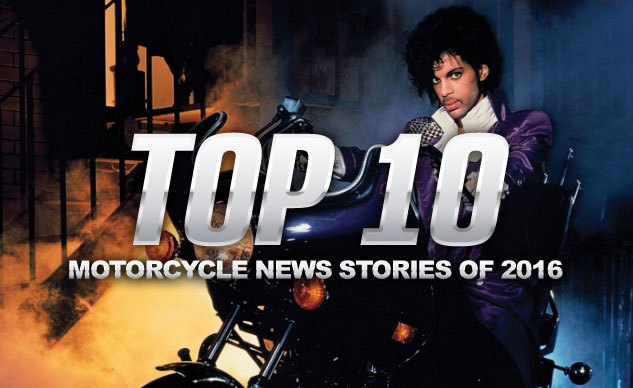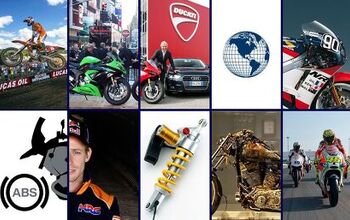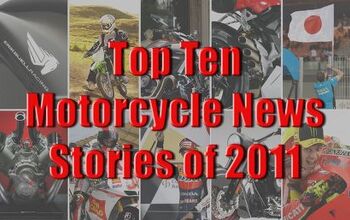Top 10 Motorcycle News Stories of 2016

The moto industry makes news, and we break it!
Let’s face it; by many accounts, 2016 was an awful year. We had terrorist attacks and the Zika virus, police shootings and the normalizing of the “Alt-Right,” Brexit and whatever the hell Ryan Lochte did at that gas station in Rio.
There was also the loss of cultural icons such as David Bowie, Prince, Muhammad Ali, Gene Wilder and John Glenn. And let’s not even get into Harambe the gorilla.
The motorcycle industry was relatively sane in comparison to the rest of the world. Sure, it had its ups and downs, but at least it gave us respite from a world where being a Kardashian is still a thing. Here are some of the top motorcycle news items of 2016.
10. KTM Enters MotoGP
KTM made its MotoGP debut this season, with Mika Kallio riding the RC16 as a wild card at Valencia. Kallio qualified 20th out of 22 riders and retired from the race after 19 laps due to problems from a broken sensor. It wasn’t the result KTM was hoping for but the race did provide valuable experience for the Austrian company’s MotoGP program. Things get real next season as KTM enters the series full-time with former Tech 3 riders Bradley Smith and Pol Espargaro.
KTM is also entering the Moto2 series next season with Brad Binder and Miguel Oliveira. Together with its long established Moto3 program, KTM will have riders competing in all three Grand Prix classes. Not bad for a company best known for its off-road racing lineage.
9. Erik Buell Racing Sold to Liquid Asset Partners
After a year of uncertainty in 2015, things started turning around for Erik Buell Racing as the company was acquired in January by Liquid Asset Partners, which announced plans to get EBR back up and running.
The new owners got to work, restarting production and establishing a dealer network and even returning to racing. Erik Buell remains with the company as its Chief Technical Officer.
At the Long Beach IMS, EBR revealed a new Black Lightning variant on the 1190SX while also announcing plans to expand the 1190 range while developing a new “sub-$10k platform” for 2018. As always, anything Erik Buell is involved in will be interesting to watch.
8. Financial Troubles for MV Agusta
Things were less rosy for MV Agusta this year, as the company continued to struggle with its finances. In March, MV Agusta filed for “concordato in continuità,” an Italian form of insolvency, to help deal with a 40 million euro debt.
This lead to rumors that Mercedes-AMG would increase its 25% stake in MV Agusta, but the relationship between the two brands appeared to sour, most notably when MV’s World Superbike team dropped the AMG logo from its racing livery.
MV Agusta may have found a savior in international investment firm Black Ocean, which signed a capital increase agreement in November. Terms of the deal were not released, but the increased funding should help MV Agusta get a better handle on its debt while getting production up and running again.
7. Kumamoto Earthquake
Japan was hit by two significant earthquakes in April, registering magnitudes of 6.2 and 7.0 on the Richter scale. The epicenter of the quakes was Kumamoto Prefecture, which is home to a Honda manufacturing facility which produces 250,000 motorcycles a year.
The Kumamoto factory was severely damaged, slowing Honda production for several months and affecting the worldwide supply of models such as the CBR1000RR, Gold Wing and the Africa Twin. The facility didn’t return to full production until Aug. 22.
6. Jorge Lorenzo Signs with Ducati
Jorge Lorenzo has been a MotoGP championship threat since entering the premier class in 2008. In nine seasons, Lorenzo captured world championships in 2010, 2012 and 2015 while tasting victory 44 times in 156 races, all with the factory Yamaha team.
Top 10 Reasons Jorge Lorenzo Should Go To Ducati
It will be a whole new paradigm in 2017 with Lorenzo signing a two-year contract with the improving Ducati factory team to ride the Desmosedici. Meanwhile, Yamaha signed the up-and-coming Maverick Vinales to race alongside Valentino Rossi. Vinales performed admirably this season for Suzuki, earning his first MotoGP race victory and finishing fourth overall in the championship in just his second season in the premier class. Yamaha hopes Vinales continues on this upward trajectory, while Ducati pins hope that Lorenzo will finally fill the void left when Casey Stoner departed after the 2010 season.
5. Nine Different Winners in MotoGP
A common complaint with MotoGP in recent years is that the same riders keep winning every race. The 2015 season was a prime example, with 18 wins divided by MotoGP’s four established “aliens,” Marc Marquez, Dani Pedrosa, Valentino Rossi and Jorge Lorenzo.
The season started out with the usual suspects on top of the podium, with Marquez, Rossi and Lorenzo splitting the first seven races. A victory by Jack Miller in Assen seemed to be an anomaly but it kicked off a stretch that saw wins by Marquez, Andrea Iannone, Cal Crutchlow, Maverick Vinales, and Dani Pedrosa. With Andrea Dovizioso winning in Sepang, the 2016 MotoGP season counted nine different winners, a new record for the premier class.
Several factors came into play to make this happen. A standardized ECU and a switch to Michelin tires from Bridgestone rubbers helped matters, as did the re-emergence of Suzuki and Ducati as credible competitors.
4. Police Officer Pepper Sprays Motorcyclists
No story drew as much ire from our readers this year than the tale of Fort Worth police officer William Figueroa, a.k.a. the Pepper Spraying Cop. Officer Figueroa was captured on video using pepper spray to force a group of riders to give him a wide berth during a traffic stop.
Figureroa was placed on administrative leave as the Fort Worth PD performed an internal investigation. The FWPD later issued internal sanctions (which could include retraining or a simple admonishment from the commander) and returned him to active duty, a decision that left a bad taste for many readers.
3. Growth of the Small-Displacement Segment
In recent years, we’ve seen more and more manufacturers getting into the small displacement segment that, for a long while, at least in the sporty-bike category, almost entirely belonged to Kawasaki. Honda entered the entry-level market a few years ago with its CBR250R and we’ve since seen more competition from Yamaha, KTM, Suzuki and most recently BMW with its G310R.
This segment is entering new ground with the introduction of small-displacement adventure bikes including the Honda CRF250L Rally, Kawasaki Versys-X 300, Suzuki V-Strom 250, and BMW G310GS. And we’re not done, as KTM also looks to get into the mini-ADV market with a 390 Adventure.
The industry hasn’t forgotten about the small-displacement sportbikes either, with a new Supersport 300 class announced for the 2017 World Superbike season.
2. California Formally Recognizes Lane Splitting
Motorcyclists in California have long been the envy of riders across the country, not just because of the state’s almost perpetual good weather, but also because of its stance on lane splitting. Contrary to popular belief, however, lane splitting wasn’t technically legal so much as it was not illegal.
That changed this year with the adoption of Assembly Bill 51 which formally allowed motorcyclists to pass other vehicles by traveling along the lane line.
Does this really change things for riders in California? Not really, though AB51 does allow the Department of the California Highway Patrol to develop guidelines on how to safely lane split. As for the rest of the country, the hope is the law will help set an example for other states to eventually adopt lane splitting like most of the rest of the world.
1. Manufacturers Prepare for Euro 4
If it seems like there were more new and updated bikes than usual this year, we only have to look to Europe for the reason why. New Euro 4 regulations come into effect Jan. 1, 2017, and this year saw a number of updates as manufacturers worked to meet the new standard for motorcycles sold in Europe.
While the new regulations are only required for Europe, its effects are felt on models sold in other markets, including here in the U.S. due to economies of scale. Euro 4 also forced manufacturers to discontinue some models (such as the Kawasaki W800) or reduce their offerings for the European market ( Victory, for example, will only offer four models in Europe for 2017).
Euro 4 emission levels are nearly twice as strict as the previous Euro 3 levels, resulting in a lot of motorcycle suddenly gaining bulkier (and uglier) exhaust systems. The new regulations go beyond emissions, however. Motorcycles with engines larger than 125cc must come standard with anti-lock brakes, while smaller bikes must have either ABS or a combined braking system.
Other new requirements include an On Board Diagnostics system (OBD 1), daytime running lights and side reflectors (which have been required in the U.S. for decades).
Manufacturers can’t start getting complacent, however, as the playing field is set to change again in 2020 when the even more stringent Euro 5 regulations are set to kick in.

Dennis has been a part of the Motorcycle.com team since 2008, and through his tenure, has developed a firm grasp of industry trends, and a solid sense of what's to come. A bloodhound when it comes to tracking information on new motorcycles, if there's a new model on the horizon, you'll probably hear about it from him first.
More by Dennis Chung






































Comments
Join the conversation
For me #5 is #1. I don't envy the Top 10 writing assignment. Nice list Dennis.
"police shootings and the normalizing of the “Alt-Right,” Brexit "
I don't go to political sites for motorcycle info, and I don't need Motorcycle.com lecturing me on politics.
I declined to click-thru your list.